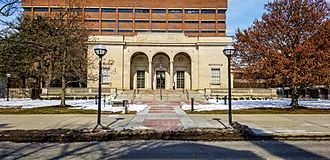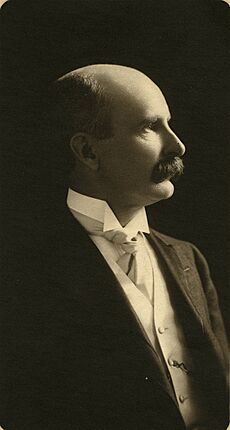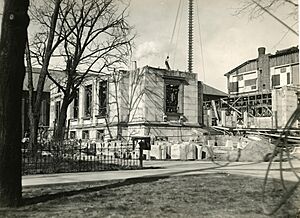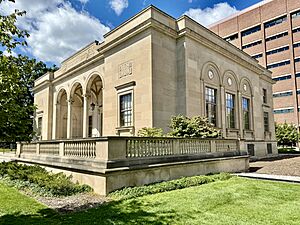William L. Clements Library facts for kids
Quick facts for kids William L. Clements Library |
|
|---|---|

William L. Clements Library
|
The William L. Clements Library is a special place at the University of Michigan in Ann Arbor, Michigan. It's like a treasure chest filled with old and rare books, letters, and maps. This library focuses on the history of North America, especially before the 1900s.
The Clements Library has four main types of collections: Books, Manuscripts (old handwritten papers), Graphics (pictures and photos), and Maps. It has many original historical items, especially about social history, the American Revolution, and how North America was settled.
Imagine this: the library holds 80,000 rare books, small booklets, posters, and old magazines. It also has 600 atlases, about 30,000 maps, nearly 100,000 prints and photographs, and thousands of old letters and documents.
Many people visit the Clements Library each year, including students and scholars from all over the world. Even famous authors like Pulitzer Prize winner David McCullough have used its collections for their books, such as 1776. The library building itself was designed by a famous architect named Albert Kahn.
Contents
History of the Library
The Clements Library was started in 1923 by William L. Clements. He was a former student and leader at the University of Michigan. Mr. Clements was a passionate collector of items about the discovery of the Americas and the American Revolution.
He gave his amazing personal collection to start the library. This included 20,000 rare books, 2,000 old newspapers, hundreds of maps, and important papers from William Petty, 2nd Earl of Shelburne, a British Prime Minister. When the library opened, Mr. Clements even wrote a book about how he gathered his collection. A newspaper, the New York Times, praised the library, saying it could answer almost any question about America between 1492 and 1800.
Besides his collection, Mr. Clements also gave money to build the library. The building was designed by Detroit architect Albert Kahn. It looks like an Italian Renaissance building, inspired by an old Italian villa.
Mr. Clements wanted the library to be special and separate from the main university library. It still has its own governing board today. However, you can find its items listed in the University Library's online catalog.
From 1935 to 1945, Howard Henry Peckham worked as a curator for the library. During this time, the Clements Library became known worldwide for its collections about the Revolutionary War and British Colonial America.
What the Library Collects
The library's collections are organized into four main areas: the Book Division, the Manuscripts Division, the Graphics Division, and the Map Division.
The library often has exhibits that show off its cool collections. These displays are open to the public on weekday afternoons. You might see rare books, old letters, maps, photos, and prints. Past exhibits have explored topics like the history of wine in America, the sugar trade, 19th-century sports, and the War of 1812.
Book Division: Rare Books and More
The Book Division holds about 80,000 items. These include books, small booklets, posters, and old magazines. Some of the most important items are books about the discovery and exploration of North America. There are also many books printed in colonial America and items from the American Revolution.
Beyond Mr. Clements' original interests, the library also has books on many other subjects. These include African American history, education, Native American history, politics, religion, old speeches, slavery and the fight against it, the the West Indies, and women's history. Other collectors have also added to the library's strengths, like collections on crime and the Civil War.
Manuscripts Division: Old Letters and Documents
The Manuscripts Division takes care of about 2,600 collections of old letters, documents, diaries, and financial records. Most of these are from North America in the 1700s and 1800s. This division is especially strong in materials from the Revolutionary War era, British-American colonial history, and military history.
Other important topics include the Civil War, social and religious movements of the 1800s (like the abolitionist movement to end slavery), African American and Native American history, women's history, education, naval and maritime history, health, travel, and business.
William L. Clements started collecting manuscripts in the early 1920s. With the library's first director, Randolph Adams, he acquired many key collections. These include the papers of British Prime Minister William Petty, 2nd Earl of Shelburne, military commanders Thomas Gage and Henry Clinton, and abolitionists Angelina Grimké, Sarah Grimké, and Theodore Weld.
Map Division: Exploring the World
The map collection shows how our understanding of the Americas grew from the 1400s to the 1800s. It focuses on military history in North America, how the frontier expanded, and the history of cartography (map-making). The Map Division was created because Mr. Clements collected so many maps and plans.
The Map Division holds about 30,000 maps and plans. About 1,500 of these are original handwritten maps. Many came with important collections like the Gage and Clinton papers. This makes the collection especially rich in maps from the American Revolution. Besides separate maps, the Clements Library also has 600 atlases.
Graphics Division: Pictures and Art
The Graphics Division holds prints, photographs, printed items for everyday use, original artwork, sheet music, and realia (real objects).
When William L. Clements started the library, he had a small collection of portraits and some Revolutionary War cartoons. But he wasn't very interested in pictures. The Graphics Division, started in 2002, mostly has items collected over the last 30 years. The photograph collection has grown very fast, from fewer than 100 items in the 1970s to over 150,000 by 2015.
The subjects in this division match the other Clements divisions. They include American military history, political and social history, American city and landscape views, portraits, satire (funny pictures that make a point), popular culture, fun activities, work, technology, travel, and food history. You can find examples of almost every printing and photographic method used from the 1400s to the 1900s in these collections.
The library recently acquired the David V. Tinder Collection of Michigan Photography. This collection has over 100,000 photographs taken in Michigan from about 1845 to 1980.
Here are some approximate numbers for the Graphics Division:
- Prints – 9,400 items
- Photos – 150,000
- Ephemera (everyday items) – 10,000
- Sheet music – 15,000
- Artwork – 150
- Realia (objects) – 100
Clements Library Associates
The Clements Library Associates are people who support the library. They pay a membership fee, starting at just $5 for students. This program began in 1947. It's estimated that members have helped the library buy historical materials worth millions of dollars today. Associates are invited to attend library programs, talks, and exhibits for free. Members also receive the library's magazine, The Quarto, which shares news and new acquisitions.
See also
- William Wright Abbot – an archivist who worked on editing and publishing The Washington Papers
- Archive and Archival research
- Peter Force – an early American archivist known for a large collection of historical materials from colonial America and the American Revolution
- James Kendall Hosmer – an American history professor and librarian




